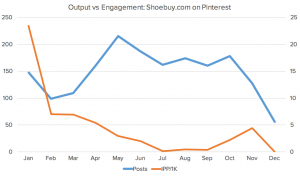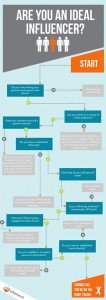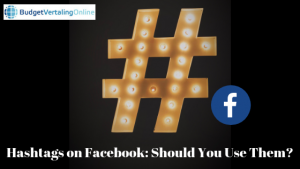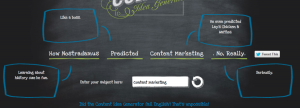What if your KPIs aren’t telling you the whole story? Contributor John Steinert explains why you need to uncover the blind spots in your approach.

If you’ve been in the B2B marketing business for fewer than 15, you’ve been operating in the first generation of data-driven marketing’s golden age. The internet and the tools we use to leverage it give us the ability to be more fact-led than ever.
And yet, despite the huge proliferation of powerful enablers, there remains a reality we should stay cognizant of: As human beings, we’re prone to ignore things that are not right up in our face.
Right now, for example, many companies are clearly neglecting their brand presence in their market. As a direct result of this neglect, all their marketing and sales efforts significantly underperform.
TechTarget, my employer, just completed a study that demonstrates this clearly in B2B tech. The yet-to-be released research has rejuvenated even my own understanding about the impact of digital “branding” tactics on end-to-end marketing and sales performance.
I’ll share a preview of this research, but before I do, let’s look at some of the reasons why many companies under-invest in the kind of marketing activity that improves brand consideration.
Martech myopia/demand-gen tunnel vision
In my mind, the cause of the problem is related to what Harvard Business School’s Theodore Levitt articulated more than 50 years ago when he coined the term “Marketing Myopia” (a quick definition here).
We all have blind spots that prevent us from acknowledging key shortcomings in our marketing plans. Information gaps, culture and other pressures can cause us to block out the facts of how our market and our marketing actually interact.
While the rise of martech has definitely given us the ability to attribute business impact to our actions, at the same time, attribution has become a key consideration in how we ourselves are evaluated. So, like business people in any role, we focus our energies on driving our KPIs. But the reality is that many of us are at the mercy of KPIs that only tell part of the story.
Dangers of KPIs not keeping pace
What if our KPIs aren’t evolving even as we learn? What if they don’t adequately represent what we really should be doing? That’s the situation many of us face.
By becoming obsessed with things like CPL (cost per lead) and MQL (marketing-qualified lead) alone, we operate with tunnel vision, blind to potential pitfalls that keep us from better performance. We’ve lost sight of the need to establish the right conditions to drive better conversion rates.
In our efforts to attribute impact to our actions, we focus most of our energy on what we personally do, often giving short shrift to the whole of what we need to better achieve our goals.
For example, if we don’t get enough email click-throughs, we send more emails to make up the difference. If our events don’t pull, we use enticing promotional giveaways, run more events, or otherwise treat the symptoms without really addressing the causes.
The specific issues:
• Inbound is not enough. With rare exceptions, most companies lack the search power to draw in the share of the market they deserve using inbound techniques alone. The fact is, you are probably not well-known enough for people to find you. No matter how great your offering, most markets are simply too crowded.
Unless you can successfully go outbound, you simply won’t get the consideration you deserve. That said, outbound limited to classic demand-gen techniques is also inadequate. Our experience shows us that for optimal outcomes, you must deploy a mix of campaign types, usually simultaneously.
• ‘Leads’ and real consideration have become very different animals. Without a doubt, the pressure on marketers to focus on top-of-funnel KPIs like high lead volumes and low CPL has contributed to the evolution of a supplier market specializing in high volumes at low cost. Yet if a “lead” would not truly consider you, it isn’t a lead with any real value, and it won’t ever reach your pipeline. Thus, your waterfall will leak horribly at either the SQL (sales-qualified leads), the SAL (sales-accepted lead) or both.
As SiriusDecisions notes, for many companies SQL/SAL conversions are just half of what they should be (were their qualification concept more mature). And yet, in our work, we still encounter remarkably few qualification concepts that factor in consideration criteria — i.e., would this company really consider doing business with us?
• Consideration has an indirect effect on KPIs but a compounding benefit to ROI. Our research shows that in the presence of consistent brand consideration activity, you successfully engage more active prospects, convert more to MQLs and deliver more accepted SQLs that close more readily.
On the flip side, when this activity is inconsistent, the impact wanes. And when it is completely absent, outcomes decline at each funnel stage.
The challenge seems to be that these branding activities are too often evaluated in isolation, rather than for the impact they have on demand measures. As such, they are prone to falling right into our blind spots — they become easy prey to myopic purse-string tightening.
Data-driven branding improves outcomes at every funnel stage
In June of this year, Demand Gen Report published a survey on what buyers themselves believed to be the effect of branding efforts on their own perception of a vendor during a buyer’s journey.
This self-reported data showed that a full 63 percent remember encountering branding material, and as many as 32 percent of customers willingly acknowledge that they are positively influenced by brand techniques.
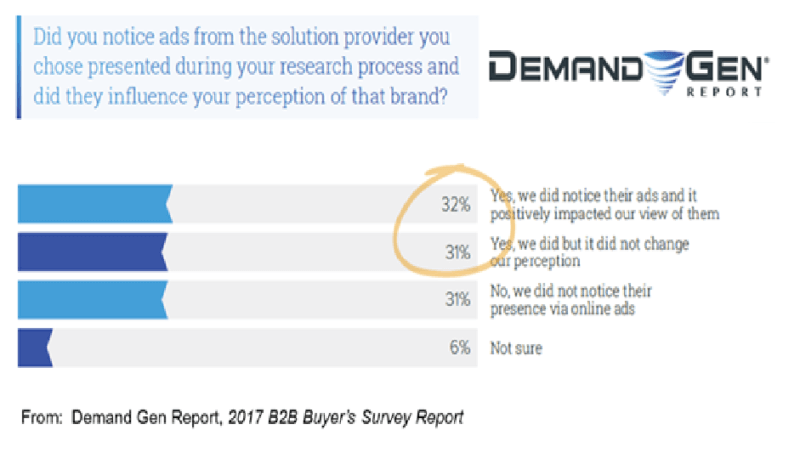
Our research takes this insight another step further, by combining directly observed funnel conversion analysis with survey reporting on which brands were being considered in verified deals. We see both the direct effect of branding activity on consideration rates and the impact they have together on funnel conversion end-to-end.
By analyzing 111,000 IT solution deals and 1,675 branding campaigns from 2015 to 2017, we learned that when B2B marketing included brand consideration techniques synchronized with demand generation, practitioners can achieve a 28 percent growth in click-through rates and a 25 percent improvement in MQL/SQL conversion.
The compounded impact of these effects can deliver as much as a 2x improvement on ROI to the bottom line.
What now?
I continue to be blown away by the innovative efforts being driven by all kinds of B2B marketers. At the same time, there are many practitioners who have hit performance plateaus and just can’t seem to break through.
If that describes where you’re at, I suggest taking a step back and trying to uncover blind spots in your overall approach. Our experience shows that chances are pretty good you’ll discover gaps impacting performance that your current KPIs may persuade you to ignore.
Reassess KPIs in 2018 planning
Our new insights tell us that inbound marketers and demand-gen experts alike can benefit by holistically reassessing their efforts. We believe that for truly significant end-to-end improvement in yields and ROI, many companies should include a more balanced and consistent integrated approach. They should be investing in branding for better consideration.
If you suspect that your KPIs could be boxing you into a worldview that’s blocking further progress, work with your stakeholders on including a proof of concept for change early next year. That could well open the door to better performance than you’ve ever seen.
Some opinions expressed in this article may be those of a guest author and not necessarily Marketing Land. Staff authors are listed here.
Marketing Land – Internet Marketing News, Strategies & Tips
(27)
Report Post

